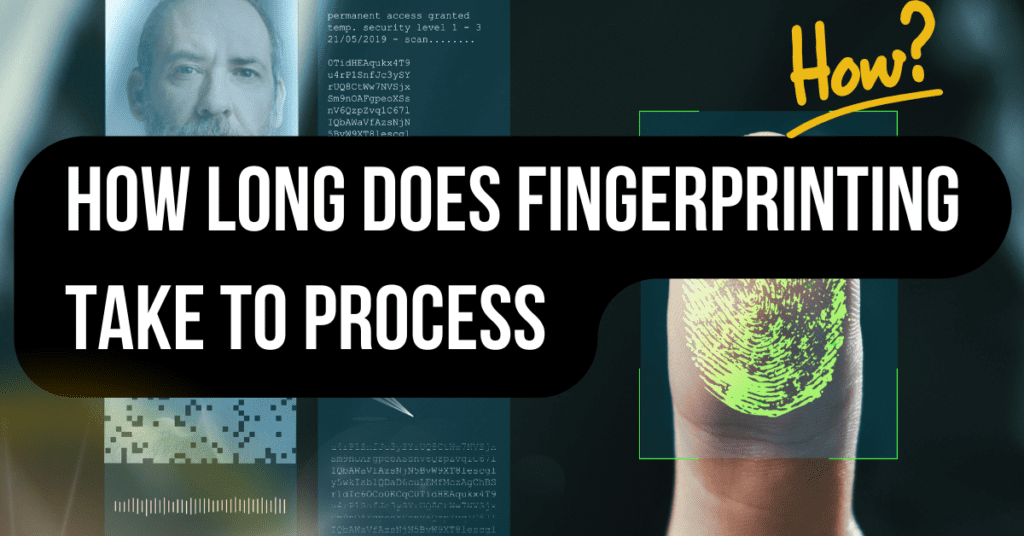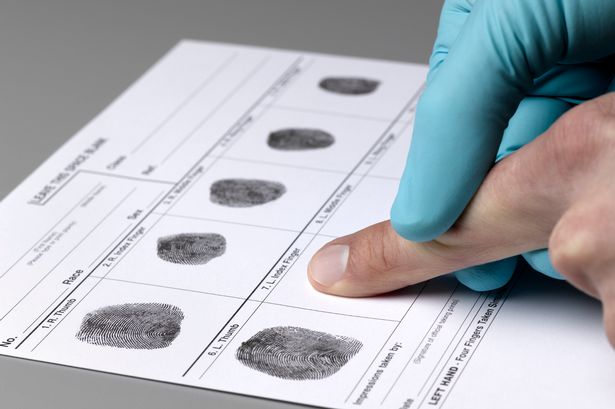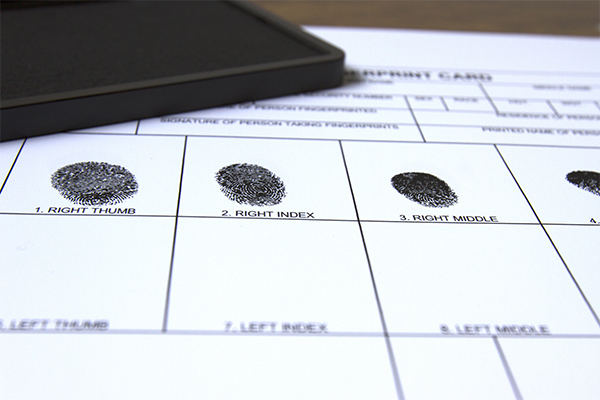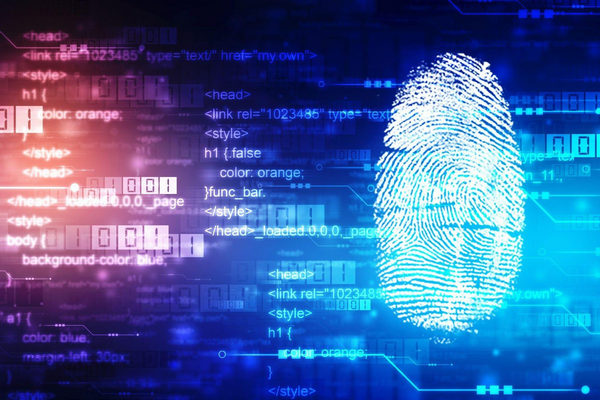
Fingerprints, the unique imprints left by our fingertips, wield an extraordinary significance across diverse fields, serving as a cornerstone in identification, forensic science, and security measures. Their unparalleled uniqueness has made them an invaluable tool for law enforcement agencies, immigration authorities, and even in everyday applications like unlocking smartphones.
Understanding the timeframe required for fingerprint analysis holds crucial implications in these sectors, impacting investigations, security protocols, and administrative procedures. Delving into the question of how long it takes for fingerprints to come back unravels a process steeped in precision, technology, and the intricacies of human identification.
What Are Fingerprints Used For? How Long Does Fingerprinting Take to Process
Fingerprints serve as a distinct, unalterable identifier, playing a pivotal role across various domains:
- Forensic Identification: In criminal investigations, fingerprints are crucial for linking suspects to crime scenes or identifying unknown individuals. They help establish connections or exclusions, aiding law enforcement in solving cases.
- Biometric Security: With advancements in technology, fingerprints are used to secure access to devices (like smartphones and laptops), buildings, and high-security areas. Biometric scanners authenticate users based on their unique fingerprints, enhancing security measures.
- Immigration and Border Control: Fingerprints are utilized in border control and immigration procedures worldwide to verify individuals’ identities, prevent fraud, and track entries and exits across borders.
- Personal Identification: They’re often employed for identity verification in official documents like passports, driver’s licenses, and various government-issued IDs.
- Historical and Archeological Studies: Fingerprints found in ancient artifacts or historical documents contribute to understanding human history, identifying individuals, and providing insights into ancient societies.
- Medical Records and Research: In certain medical scenarios, fingerprints can be used for patient identification, and they’ve also been studied for potential indicators of certain diseases or genetic conditions.
Their uniqueness, permanence, and ease of collection make fingerprints an invaluable tool in numerous fields, aiding in identification, security, and research.
How Long Does It Take to Get Results Back?

The time it takes to receive results from a fingerprint-based background check can vary significantly based on several factors:
- Type of Background Check: Different types of background checks might have varying processing times. For instance, a standard employment background check might take less time compared to a more comprehensive check required for security clearances or immigration purposes.
- Jurisdiction and Agency: The agency or organization conducting the background check plays a significant role. Some agencies have faster processing times due to their resources and workload, while others might take longer.
- Fingerprint Quality: If the fingerprints captured are clear and of high quality, it might expedite the identification process. Poor-quality prints might require re-submission, delaying the results.
- Database Access and Matches: The time taken to search through databases for matches can influence the speed of results. More extensive databases or more thorough searches might take longer.
- Overall Workload: The workload of the agency or department conducting the background check can impact processing times. High volumes of requests could result in longer waiting periods.
Generally, some basic background checks might yield results within a few days to a couple of weeks. However, more comprehensive checks, especially those involving federal agencies or security clearances, can take several weeks or even months. Agencies often provide estimated timelines for results, but these are subject to change based on the factors mentioned above.
It’s essential to inquire with the agency or organization conducting the background check for an estimated timeframe and to account for potential delays due to various factors that could affect processing times.
Who Conducts the Background Checks?
Background checks can be conducted by various entities, depending on the context and purpose:
- Employers: Companies often perform background checks on potential employees as part of their hiring process. These checks can involve verifying education, employment history, criminal records, credit history (if relevant), and professional licenses.
- Government Agencies: Law enforcement and government agencies conduct background checks for various purposes, including firearm purchases, security clearances, immigration procedures, and licensing for certain professions (such as law, healthcare, or finance).
- Volunteer Organizations: Groups working with vulnerable populations, such as children or the elderly, often conduct background checks on volunteers to ensure the safety of those they serve.
- Landlords and Property Managers: When renting out property, landlords or property management companies may conduct background checks on potential tenants to assess their reliability and potential risk.
- Financial Institutions: Banks and financial institutions may conduct background checks as part of the process for loan approvals, especially for larger amounts or in commercial lending.
The specific entity conducting the background check may vary based on regulations, industry standards, and the purpose of the check. The checks can include various components, such as criminal history, credit reports, employment verification, education verification, and more, tailored to the needs of the organization or situation.
What Is Needed for Fingerprint background checks Submission?

Submitting fingerprints for a background check typically requires specific elements to ensure accuracy and verification. Here’s what’s usually needed:
- Fingerprinting Service: Individuals need to visit an authorized fingerprinting agency or service provider. This can be a law enforcement agency, private fingerprinting company, or a designated facility equipped to capture fingerprints accurately.
- Valid Identification: A government-issued ID, such as a driver’s license, passport, or state ID, is typically required to confirm the individual’s identity before the fingerprinting process.
- Request Form or Authorization: Some background checks require a specific request form or authorization, which might include details about the purpose of the background check and the agency or organization requesting it.
- Payment: Depending on the jurisdiction and the reason for the background check, there might be a fee associated with fingerprinting and processing the background check. Payment is often required at the time of fingerprint submission.
- Fingerprinting Process: The individual’s fingerprints will be captured using specialized equipment, either through traditional ink-and-paper methods or digital fingerprint scanners. Multiple prints from different fingers might be required for comprehensive checks.
- Submission to Relevant Authorities: Once the fingerprints are captured, they are submitted to the appropriate authorities or agencies responsible for conducting the background checks. This can include law enforcement agencies, the FBI, state-specific agencies, or other relevant organizations depending on the nature of the check.
Accuracy and completeness in providing necessary identification and complying with the procedures of the fingerprinting service are crucial to ensure a smooth and accurate background check process.
What Can Affect the Timeline?
Several factors can impact the timeline for receiving results from a fingerprint-based background check:
- Fingerprint Quality: If the fingerprints captured are smudged, incomplete, or of poor quality, it might take longer to process them or require resubmission, delaying the overall timeline.
- Type of Check: The complexity and depth of the background check required can significantly affect the timeline. Basic employment checks might be quicker compared to more comprehensive checks for security clearances or immigration purposes.
- Agency Processing Times: Different agencies or departments responsible for conducting the background checks might have varying workloads and processing times. Some might handle a high volume of requests, causing delays in processing.
- Database Searches: The time it takes to search through various databases for matches can influence the speed of results. More extensive databases or thorough searches might require more time.
- Regulatory Requirements: Certain checks might need to comply with specific regulations or legal procedures, adding steps to the process and potentially lengthening the timeline.
- Verification and Review: After initial identification matches are found, further verification or review processes may be necessary, especially for sensitive checks, which can contribute to additional time.
- Volume of Requests: High volumes of requests can overwhelm the processing capacity of agencies, leading to delays in processing background checks.
- Legal or Administrative Issues: Legal or administrative issues, such as pending court cases or discrepancies in information, may require additional scrutiny, causing delays in the background check process.
It’s important to note that these factors can vary based on the specific circumstances of each background check and the procedures followed by the agency or organization conducting the check. Communication with the relevant authorities or agencies can provide insights into expected timelines and any potential factors that might affect the processing speed.
What Do Fingerprint Results Show?

Fingerprint results from a background check primarily focused on identifying information tied to the individual’s fingerprints. Here’s what these results typically entail:
- Identification: The foremost purpose is to match the fingerprints provided to existing records in databases. If a match is found, the results confirm the individual’s identity and any associated information linked to those fingerprints.
- Criminal History: One of the critical aspects of fingerprint-based background checks is revealing any criminal history associated with the individual. This includes records of arrests, convictions, warrants, and other law enforcement-related information.
- Aliases or Aliases Used: If an individual has used different names or aliases, the fingerprint results might show these alternative identities if they are linked to the fingerprints on record.
- Biographical Information: In some cases, fingerprint results might also include basic biographical information such as date of birth, address, and other identifying details.
- Clearance or Eligibility: For certain applications like security clearances or immigration, fingerprint results might determine an individual’s eligibility or clearance status based on established criteria.
- Verification of Identity: The results essentially serve as a means of verifying the individual’s identity, often used for employment screenings, background checks for licensing, or security-related purposes.
It’s important to note that the information revealed in fingerprint results can vary based on the specific purpose of the background check and the databases accessed by the agency conducting the check. Additionally, the level of detail provided in the results might also depend on the jurisdiction and the laws governing the release of such information.
What Are Fingerprint Database Limitations?
Fingerprint databases are highly valuable for identification and background checks, but they do have limitations:
- Incomplete Records: Not all individuals have their fingerprints recorded in databases. Some people might have never been fingerprinted, especially in cases where they haven’t had interactions with law enforcement or government agencies.
- Quality of Prints: The accuracy of fingerprint databases heavily relies on the quality of the prints collected. Poor-quality or smudged prints can lead to inaccurate matches or no matches at all.
- Errors in Data Entry: Mistakes can occur during the data entry process, leading to inaccuracies in the database. Typos, misinterpretations, or clerical errors could affect the matching process.
- Limited Access to Certain Databases: Access to fingerprint databases might be restricted or limited based on jurisdiction, laws, or regulations, which could hinder comprehensive background checks.
- Cross-jurisdictional Issues: Databases might not always be interconnected between different jurisdictions or countries. This could lead to difficulties in accessing relevant information from different databases, especially in international cases.
- Aging Records: Over time, older fingerprint records might become less accessible or might not be as comprehensive due to changes in technology, storage methods, or archival procedures.
- False Positives or Negatives: While fingerprint matching is highly accurate, there’s still a small margin for error. False positives (incorrectly identifying two different prints as a match) or false negatives (failing to match prints that are the same) can occur, albeit rarely.
- Privacy and Legal Constraints: Legal regulations and privacy concerns might restrict the sharing or use of fingerprint data for certain purposes, impacting the depth or scope of background checks.
Improvements in technology, data sharing agreements, and advancements in fingerprint analysis continue to address many of these limitations. However, it’s essential to recognize these constraints when relying on fingerprint databases for identification and background checks.
Is There Any Way to Speed Up the Process?
There are a few strategies to potentially expedite the fingerprint-based background check process:
- Provide Clear and Complete Information: Ensure all necessary information is accurately provided during the fingerprinting process. This includes valid identification and any required authorization forms. Any mistakes or missing details can cause delays.
- Choose Authorized and Efficient Service Providers: Opt for authorized fingerprinting agencies or facilities known for their accuracy and efficiency in capturing prints. This reduces the chances of needing to redo the process due to poor-quality prints.
- Follow Up and Inquire About Progress: Contact the relevant agency or organization periodically to inquire about the status of your background check. Sometimes, a gentle reminder can prompt them to expedite the process.
- Understand the Process Timelines: Different types of background checks have varying processing times. Understanding the estimated timelines for the specific type of check your undergoing can help manage expectations.
- Provide Accurate and Consistent Information: Ensure that all information provided during the background check process, including personal details, matches consistently with official records. Inconsistencies might require further verification, causing delays.
- Check for Errors or Discrepancies: Review the information provided for accuracy before submitting it. Errors or discrepancies could result in delays as authorities verify or rectify the information.
- Consider Expedited Services (If Available): Some agencies or providers offer expedited processing for an additional fee. If time is of the essence, this might be an option worth exploring.
Remember, while these strategies can potentially speed up the process, there might still be factors beyond your control, such as workload at the agency conducting the checks or legal requirements. Communication and cooperation with the relevant authorities or agencies can help navigate the process more effectively.
What Are the Potential Risks?
When dealing with fingerprint-based background checks, there are some potential risks to consider:
- Privacy Concerns: Sharing fingerprint data involves sensitive personal information. There’s a risk of data breaches or misuse, which could compromise an individual’s privacy.
- Inaccuracies: While fingerprint matching is highly accurate, there’s still a small margin for error. False positives or false negatives can occur, leading to incorrect identifications or missed matches.
- Stigmatization and Discrimination: In some cases, individuals might face stigma or discrimination based on information revealed in their background checks, even if it’s inaccurate or irrelevant to the current situation.
- Limited Scope of Information: Fingerprint-based checks might not provide a comprehensive picture of an individual’s history or character. They primarily focus on criminal records associated with the fingerprints, potentially omitting other relevant information.
- Dependency on Technology: Relying solely on technology for identification and background checks can be risky. Technical failures, system errors, or database issues might hinder accurate results.
- Legal and Regulatory Risks: There are legal considerations regarding the use and storage of fingerprint data. Failure to comply with regulations or misuse of this information can lead to legal consequences.
- Financial Costs: Seeking expedited processing or utilizing specialized services for background checks can incur additional costs. This might be a concern for individuals or organizations with budget constraints.
- Limited Access or Exclusion: Some individuals might not have their fingerprints in databases for various reasons. This could potentially exclude them from certain opportunities or processes that require fingerprint-based checks.
Mitigating these risks involves understanding the limitations of fingerprint-based checks, ensuring compliance with privacy laws, advocating for fair and accurate use of the information, and staying informed about technological advancements and legal changes impacting fingerprint data usage.
Is Fingerprinting Necessary for All Crimes?
Fingerprinting isn’t necessarily required for all crimes. The decision to collect fingerprints often depends on several factors:
- Nature of the Crime: Fingerprinting is more common in cases where physical evidence is present or where there’s a higher likelihood of obtaining usable prints. Serious crimes or those involving violence, burglary, or theft often prompt fingerprint collection.
- Likelihood of Identifiable Prints: Certain surfaces or circumstances might not yield usable fingerprints. Factors like the surface texture, environmental conditions, and the offender’s actions can affect the chances of obtaining identifiable prints.
- Investigative Priority: In some cases, law enforcement might prioritize other types of evidence or investigative techniques over fingerprinting due to limited resources or the nature of the investigation.
- Misdemeanors or Lower-level Offenses: For minor offenses or misdemeanors where physical evidence is minimal, fingerprinting might not be routinely conducted unless there’s a specific need or the case escalates.
- Cost and Time Considerations: Fingerprint collection, analysis, and processing can be time-consuming and expensive. Law enforcement might weigh the benefits against the costs and time involved in fingerprinting for certain cases.
- Suspect Identification: If a suspect is identified through other means (witnesses, CCTV footage, etc.), the urgency or need for fingerprint collection might decrease.
Overall, while fingerprints can be valuable evidence in many cases, the decision to collect them depends on the circumstances of each crime and the judgment of law enforcement regarding the potential usefulness of fingerprints in the investigation.
Conclusion
Recap of factors influencing fingerprint analysis timelines
The duration for fingerprint analysis hinges on multifaceted factors—ranging from the quality of prints obtained to the workload of the agencies conducting the checks. The complexity of the background check, database accessibility, and the need for meticulous verification contribute to varying timelines.
Importance of patience and understanding for timely results
Navigating the fingerprint-based background check process requires patience. While awaiting results, understanding the intricacies and potential delays arising from legal procedures, data verification, and workload constraints is crucial. Patience becomes key in ensuring accuracy and comprehensive scrutiny for reliable outcomes.
Prospects for faster fingerprint analysis
Advancements in technology continue to reshape fingerprint analysis, promising faster and more accurate identification methods. Innovations in machine learning, enhanced databases, and improved fingerprinting techniques hold the potential for expedited identification without compromising precision. Embracing these advancements offers a promising outlook for quicker turnaround times in fingerprint-based background checks.
By acknowledging the factors influencing timelines, exercising patience, and looking optimistically towards evolving technologies, the process of fingerprint analysis can evolve, delivering efficient and dependable results in the near future.
FAQ’s
Why are my fingerprint results taking so long?
The duration for fingerprint results can vary due to multiple factors. This includes the complexity of the check, the workload of the agency processing it, the quality of fingerprints captured, and the depth of the search within databases. Delays can occur due to verification processes, database searches, or administrative procedures. Patience is key as agencies strive for accuracy while handling numerous requests.
How often do fingerprints get rejected?
Fingerprint rejections can happen due to various reasons, such as poor print quality, smudging, or incomplete prints. The rejection rate can vary based on individual factors like skin conditions, aging, or the method used for fingerprint capture. Ensuring clear and accurate prints during the initial capture minimizes the chances of rejection.
How do I know if I passed my live scan?
After undergoing a live scan, the results are usually sent to the requesting agency or organization. They will communicate the outcome of the live scan to you. If it’s for employment or licensing purposes, the organization or employer should inform you of the clearance or any issues discovered during the background check.

